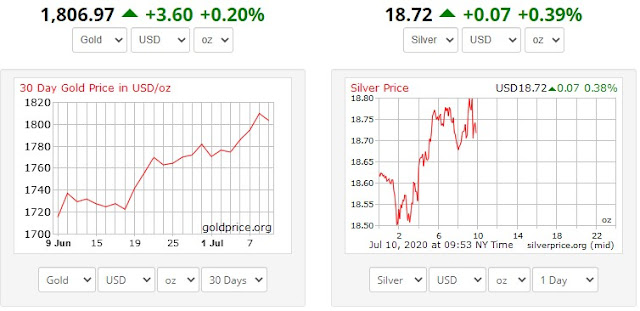Both gold and silver bullion continue to trade higher at the time of writing, moving in lock step with the ever increasing global instability that the world now faces, with none other than Central Banks leading the charge.
The king of metals, gold bullion continues to hold solidly above the $1800 USD per oz mark, with each passing day that its remains above this crucial psychological level helping to underpin its strength.
Meanwhile, the metal of the people, silver bullion has shown even greater strength over this last week, moving sharply higher and now trading above the $19.00 USD per oz level, of which it broke through in rapid succession.
Underpinning these moves higher in both and gold and silver bullion are the plethora of both political and economic instabilities that the world now faces, driven largely due to the incredible strain that the system is experiencing due to the COVID-19 pandemic, of which is diminishing in some parts of the world, while rapidly spiraling out of control in others.
Unfortunately, the United States is central to many of these problems, including the rising number of cases of COVID-19, which in many States are now higher than ever before.
This is leading to renewed "lock-downs" in key states, reduced economic activity in others and continued uncertainty in most others.
Meanwhile, the November Presidential Elections are just around the corner, which are expected to end in disaster, no matter which end of the political spectrum comes out on top, as neither side is likely to accept the results willingly.
Central Banks Shore Up Their Defense
With all of this increased uncertainty, it therefore comes as no surprise that Central Banks, as a whole are continuing on with a trend that they have been partaking in over the last number of years, that of being net purchasers of gold bullion.
Chief among these as of lately has been Turkey, of which is experiencing the sharpest percentage point increase in gold reserves, outpacing every other Central Bank in the world by a significant margin.
Throughout the month of May alone, Central Banks added a total of 39.8 tonnes of gold, continuing on with a trend of adding to reserves which was also seen in the months of March and April as well, with the overall average being 35 tonnes per month in 2020.
Although some Central Banks continue to foolishly shed gold reserves, others are only more than delighted to accumulate these sales.
One of these countries, as previously mentioned is Turkey, which acquired a total of 36.8 tonnes in May, while another Uzbekistan, added a total of 6.8 tonnes.
This overall gain in reserves comes at a time when two of the key players, both Russia and China are largely silent and missing from the gold markets, not selling any gold reserves, but also largely not partaking in purchasing as well.
However, this may be misleading, as China oftentimes will go large periods of times without reporting any changes in official reserves, silently accumulating behind the scenes as not to cause a run higher in prices, allowing them to acquire reserves at depressed prices, only then to announce a sharp increase in holdings at a latter date.
Russia on the other hand has been largely missing from the gold markets in 2020, with their Central Bank stating that they are not interested in adding to their position at the moment, however, this may soon be set to change.
The reasoning for this is due to the fact that the Central Bank of Russia recently changed course and acquired a small, however still net positive amount of gold throughout the month of May, totaling approximately half of a ton.
This goes against their recent statements of not needing to add more gold bullion to their reserves and may mark a change in rhetoric, one of which could add significant renewed demand for gold bullion from Russia, throughout the remainder of 2020 and thus send both gold and silver bullion prices to even higher heights.
Expect more demand for both gold and silver bullion throughout the remainder of 2020 and into at least the first quarter of 2021, as uncertainty is surely to only increase in the latter half of this year, increasing the need for safe haven assets, while also increasing uncertainty to all new highs.
Until then, stay safe and keep stacking.















